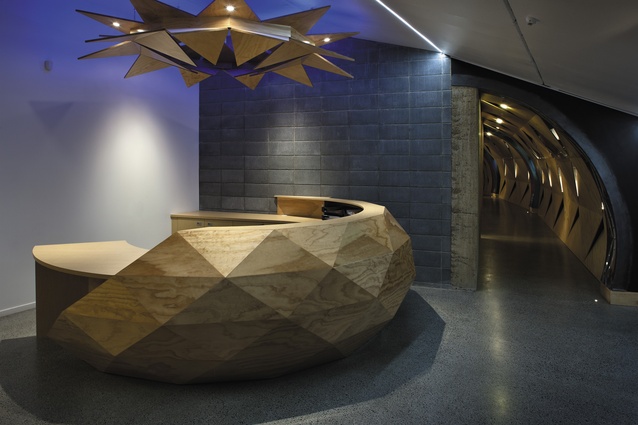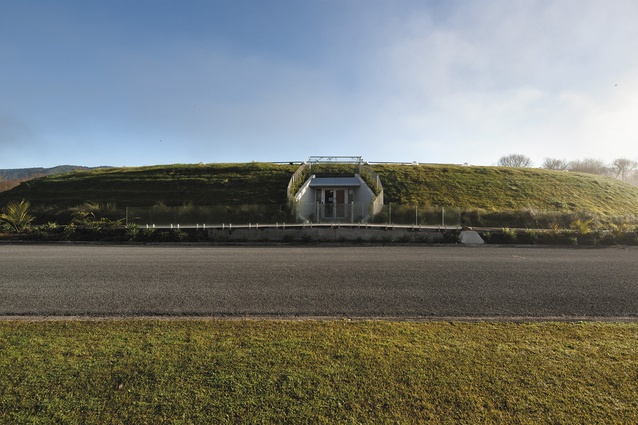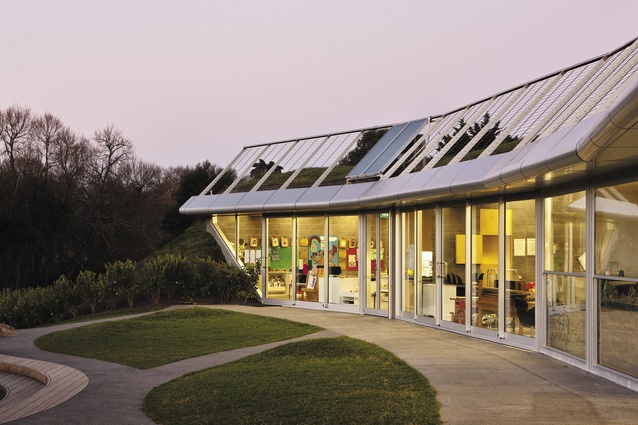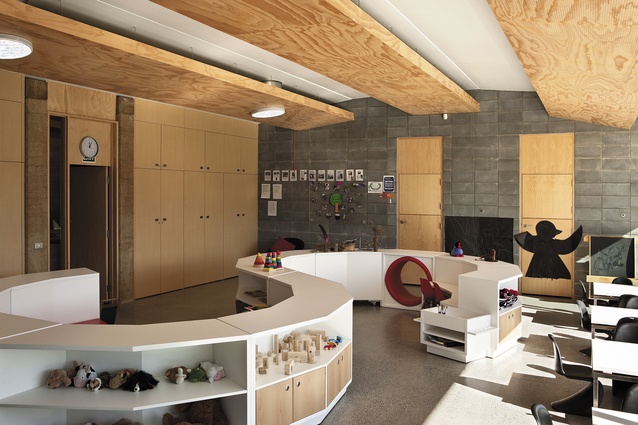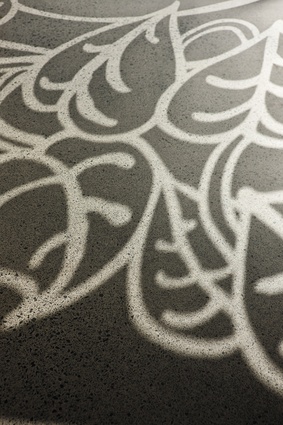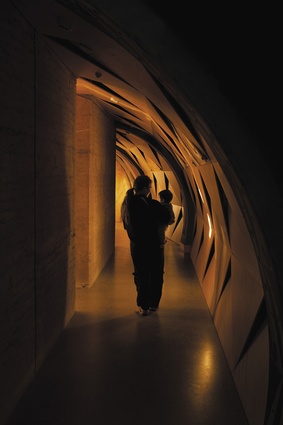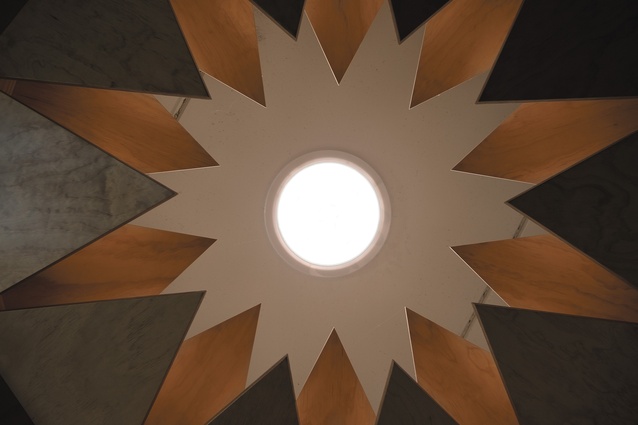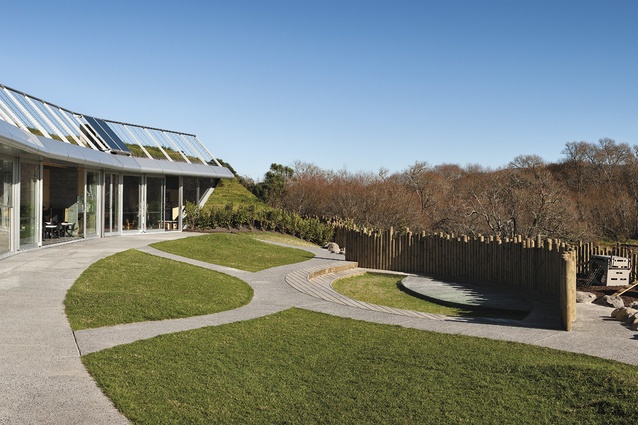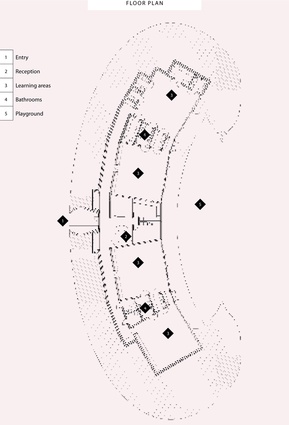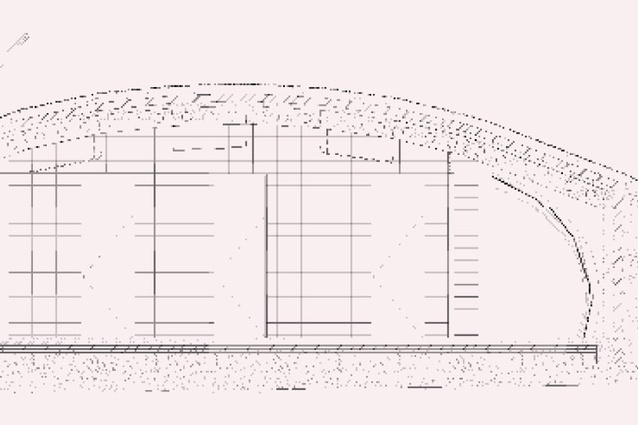Te MiruMiru
Blustery wind and a tiring car drive slip away as Margaret Wikaire from Ngāti Hine Health Trust takes me inside the mound of earth that is Te Mirumiru Early Childhood Education Centre. The building wraps warmly around us and continues holding, just enough. I imagine children and staff feeling soothed before they start a busy day.
The reception and the two corridors that curve around the semicircular building are restful, cave-like spaces with earthy tones, natural materials and quiet lighting.
The inner wall is rammed earth; the outer interior wall is concrete lined with triangular, plywood panels and “ribs” that reference ancestral posts in a wharenui. A grass-covered earth mound forms the exterior south wall so the building is well insulated. At the end of each interior “arm”, carved paintings of Ngāti Hine’s ancestor, Hineamaru and her husband Koperu of Ngāti Tu are a quiet presence.
At reception a star-shaped wood chandelier – backed by purple/blue lighting – evokes the sky and larger cosmology, although this along with the “whimsical” desk was pure design says architect Phil Smith at a later interview. The desk and light are also made of triangular plywood pieces. Triangles reference Māori use of the shape in traditional architecture, art and decoration such as tukutuku panels in wharenui, Smith says. Carvings, paintings and woven whakariki around the walls tell stories which are all part of the learning that engages children and staff at the centre.
“Our ancestors are there,” says Maxine Shortland, general manager, Mātauranga Whānui, Ngāti Hine Health Trust, by telephone. “The way it was built was to create and tell more stories of Ngāti Hine in a way that people get it.”
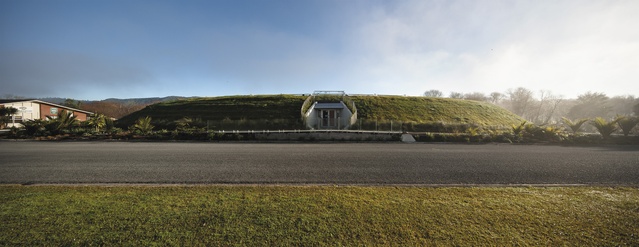
Those stories are about Hineamaru – her travels, her exploits and knowledge, the plants she grew, such as kumara – and about some of her children. They are stories about the natural environment and the healthiness of food.
The name Te Mirumiru is one of these. Hineamaru gave birth to her son Whe by caesarean section. The Mirumiru, an industrious little bird, fed and looked after Whe when his mother placed him in a tree. Symbolically, the children who attend the bilingual centre are fed with many kinds of knowledge.
Smith says the client wanted something modern and unique to the iwi’s culture.
“The building was not to be based on a typical marae- and whare-type formula. I wanted to reinterpret their culture and traditions and come up with something completely different. You start with whakapapa and lineage and everything gets layered over that.”
Through consultation with the client, kaumātua and kuia, and his own research, Smith focused on the concept of whenua (earth, womb, placenta).
“For a childcare centre, the notion of birth and what goes with it was a neat concept, and the idea that mother Earth, Papatūānuku, gives birth to everything,” Smith says.
Hineamaru lived under the earth in the nearby Waiomio caves. Another link is the underground shelters at Ruapekapeka Pā, which the ancestor Kawiti engineered as a defence from attack. A saying translated as “Ngāti Hine of a thousand hills,” is also clearly picked up in the design.
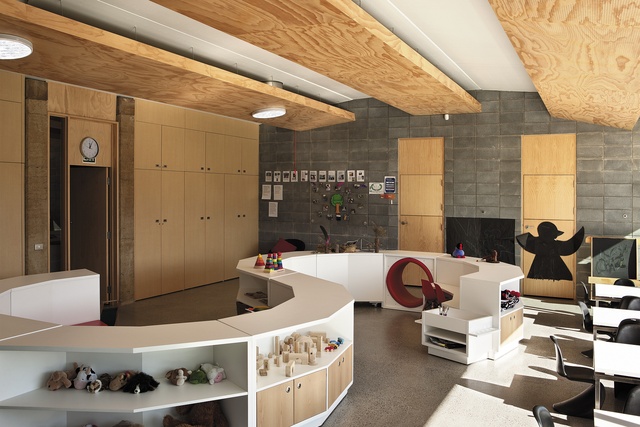
Out of the shadows we enter sunny classrooms. They are lit both by natural daylight and (when required) solar-powered lights. The concave, north-facing wall is all double-glazed windows and sliding doors with views of the sky and landscaped natural environment. The glass wall represents the cut of the caesarean section through which Whe and Ngāti Hine emerged. The children make this journey from dark to light every day in their learning and development.
Smith’s interest in Māori culture had been piqued during holidays in New Zealand. His background training and practice in England were also useful for this project.
“Growing up in the UK surrounded by heritage you almost overlook it – the church in the village I lived in was 1,000 years old. When I became an architect, I had to deal with it. If you try to do something new and modern and different it’s hard – the planners are all against you if you are doing things in cities. So, if you do anything different you learn to do things that are reinterpreted from context. You have to put a convincing argument together as to why you want to do something that isn’t traditional, unless it’s a little pointy roofed, slate-roofed cottage. If you can’t justify it you’ll never get it through planning. That is what I was doing for [Ngāti Hine], really. You look at the context, you look at the wider landscape, you look at all the clues you can, you pull them all out, you reinterpret it and you go, ‘This is it.’ I think in New Zealand that’s not something we really do. It’s a different way of looking at things – something I’ve done when you don’t have any choice.”
From a design perspective, Smith says the interior reflects a lot of the symbolism and goes a bit further in that “some of it is almost pure design because we liked it.” And then there are the practicalities of a modern educational facility.
The centre has capacity for one hundred children from zero to four years. Smith has designed many childcare centres and knows all the rules and regulations. There are four classrooms named after age-related birds: babies – pōtare (kingfisher); two-year-olds learning to talk – tūi; three- and four-year-olds - pūkeko and kiwi respectively. A kitchen is centrally placed and there is a teacher timeout space. Smaller rooms for separate functions such as sleeping, changing and toileting have split-level stable doors off the main classroom areas. The colour palette is simple and most materials left unpainted, which Smith says would make the place too busy. Concrete provides thermal mass, which soaks up the sun, and underfloor heating is solar powered, drawn from panels on the roof. Smith also designed the “tamariki-centric” furniture.
Plywood panels with holes on the ceiling absorb noise (acoustic levels are under-specified for childcare centres, Smith says) and all the pipe work runs behind the middle panel.
“In a passive building there is nowhere to hide anything,” Smith says. “You have to find some way of putting services through, and concealing them isn’t the easiest thing. Panels also screen the lights. The building is up for a Green Star rating, which they think could reach a six and be a first for childcare centres in Australasia.
The centre is a significant step for Ngāti Hine Trust towards helping local people achieve their aspirations, their higher educational and life goals.
“I’m really excited by it,” Shortland says. “We want to do more of these. We want to see what difference this makes for our tamariki and families’ learning. We want to see about the transitioning from here to the primary school, which we have good links to, and we just know from a sustainable point of view, working with council, that this building will not need to be replaced for a long time. It will be maintained. The building has to be resilient with the kids.”
They are also talking about the idea of situating houses in the side of a hill.
“Why not do miniature Te Mirumiru?” Shortland says. “They would be cost effective long term. We know that they would be beneficial to families.”

